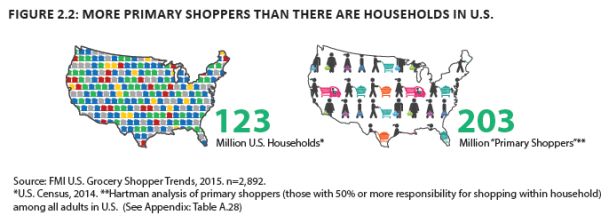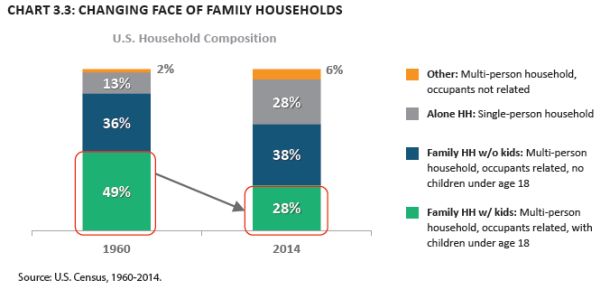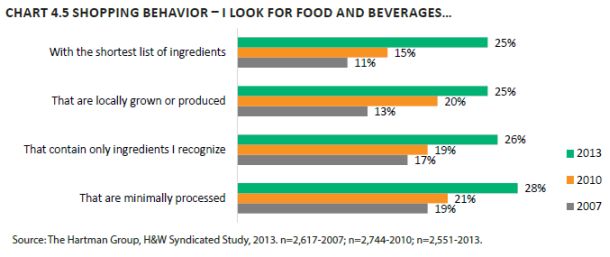Snacks now comprise 50% of all eating occasions
Eating alone, continuous snacking and the slow death of the primary shopper: 10 things you need to know about the changing American consumer

1 – LIVING, AND EATING, ALONE: The portion of Americans living alone has almost tripled since 1960, and the 34 million adults living alone now account for more than one quarter of all US households, says the FMI. So more single portions, and fast, fresh, options are a must.
Meanwhile, in 2014, 46% of all adult eating occasions took place while the person was alone, says the FMI (quoting Hartman Group data).
2 – ADULTS-ONLY: Meanwhile, the number of Americans living in ‘multi-generational households’ (comprising at least two adult generations. eg. parents and grown-up kids; boomers and elderly parents) has more than doubled since 1980, says the FMI, citing Pew Research Center data.
3 – CHANGING DEMOGRAPHICS: In 1960, the vast majority of the US population that was ‘foreign born’ came from Europe (75%), Canada (10%), Latin America (9%), Asia (5%) and somewhere else (1%).
In 2010, Europe accounted for just 12%, Canada 2%, Latin America 53%, Asia 28%, and somewhere else 5%, says the FMI (citing US Census Bureau data):
“Latino and Asian migrants account for most of today’s foreign-born population, whereas previously the vast majority came from Europe or Canada.”
4 – HELLO BOYS: Women account for 47% of the workforce today vs 38% in 1970 (Bureau of Labor Statistics data). And men, in turn, are assuming a far more significant role in cooking and food shopping, says the FMI.
In 2008, 42% of men said they had some involvement in cooking each day vs 29% in 1975. Meanwhile, 73% of men report being responsible for at least half of their household’s shopping, says the FMI, noting that growing numbers of men now describe themselves as ‘primary shoppers’, even in households where women also claim this role.
Indeed, there are more adults claiming to be primary shoppers (203 million) than there are households (123 million), notes the FMI.
Is the concept of a 'primary' shopper still valid?
“The old paradigm wherein one primary shopper directed shopping activities for a household and could represent its needs has given way to a new paradigm in which shopping is truly shared. In the emerging shared shopper paradigm, the role of the primary shopper is being replaced by multiple shoppers, who divide and share grocery shopping responsibilities." The Food Marketing Institute, 2015 US Grocery Shopper Trends report
5 – FOOD ALLERGIES: 12% of households contain people with self-reported food allergies or sensitivities (formally diagnosed or otherwise. Source: 2015 FMI national consumer survey, 2,265 American shoppers).
6 – WANING LOYALTY: Back in 2011, just 2% of consumers said they had no ‘primary grocery store’ (defined as 'the store at which I spend the most money on groceries'). In 2015, this figure rose to 9%.
7 – MILLENNIALS: 12% of Millennials – vs 5% of Boomers – shopped online for groceries in the past 30 days (source: 2015 FMI national consumer survey, 2,265 American shoppers).
Millennials are also most likely to skip breakfast and most likely to consume vegetarian food.
8 – SNACKING… CONTINUOUSLY: Snacks now comprise 50% of all eating occasions, claims the FMI (citing Hartman Group data), with 90% of US consumers snacking multiple times a day, 61% claiming to be actively seeking healthier snacks, and 48% replacing meals with snacks at least 3-4 times a week.
The American Diet: One continuous snack?
Snacks now comprise 50% of all eating occasions, with 48% of Americans now replacing meals with snacks at least 3-4 times a week, says the FMI: "Consumers now eat more often, in more isolation, in the moment and on the go."
9 – KEEPING IT SIMPLE: There was a sharp rise in the percentage of Americans claiming to look for foods with the shortest list of ingredients; foods that are locally grown or produced; foods that contain only ingredients that I recognize; and foods that are ‘minimally processed’ between 2007 and 2013, says the FMI, citing Hartman Group data.
10 – GO VEGGIE! 7% of American households contain [self-reported] vegetarians, vegans, or vegetarians and vegans (source: 2015 FMI national consumer survey, 2,265 American shoppers).
Find out more about the FMI report HERE.
















